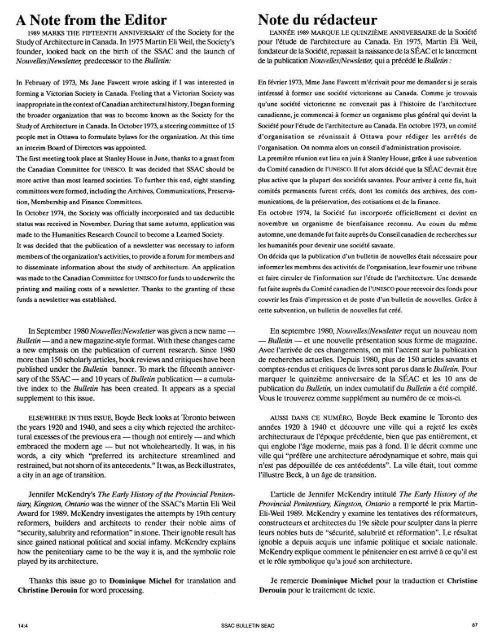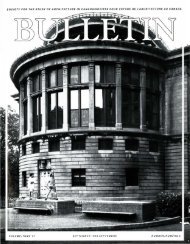society for the study of architecture in canada - SEXTONdigital
society for the study of architecture in canada - SEXTONdigital
society for the study of architecture in canada - SEXTONdigital
Create successful ePaper yourself
Turn your PDF publications into a flip-book with our unique Google optimized e-Paper software.
A Note from <strong>the</strong> Editor<br />
1989 MARKS TilE FIITEENTII ANNIVERSARY <strong>of</strong> <strong>the</strong> Society <strong>for</strong> <strong>the</strong><br />
Study <strong>of</strong> Architecture <strong>in</strong> Canada. In 1975 Mart<strong>in</strong> Eli Wei!, <strong>the</strong> Society's<br />
founder, looked back on <strong>the</strong> birth <strong>of</strong> <strong>the</strong> SSAC and <strong>the</strong> launch <strong>of</strong><br />
Nouvelles/Newsletter, predecessor to <strong>the</strong> Bullet<strong>in</strong>:<br />
In February <strong>of</strong> 1973, Ms Jane Fawcett wrote ask<strong>in</strong>g if I was <strong>in</strong>terested <strong>in</strong><br />
<strong>for</strong>m<strong>in</strong>g a Victorian Society <strong>in</strong> Canada. Feel<strong>in</strong>g that a Victorian Society was<br />
<strong>in</strong>appropriate <strong>in</strong> <strong>the</strong> context <strong>of</strong> Canadian architectural history, I began <strong>for</strong>m<strong>in</strong>g<br />
<strong>the</strong> broader organization that was to become known as <strong>the</strong> Society <strong>for</strong> <strong>the</strong><br />
Study <strong>of</strong> Architecture <strong>in</strong> Canada. In October 1973, a steer<strong>in</strong>g committee <strong>of</strong>15<br />
people met <strong>in</strong> Ottawa to <strong>for</strong>mulate bylaws <strong>for</strong> <strong>the</strong> organization. At this time<br />
an <strong>in</strong>terim Board <strong>of</strong> Directors was appo<strong>in</strong>ted.<br />
The first meet<strong>in</strong>g took place at Stanley House <strong>in</strong> June, thanks to a grant from<br />
<strong>the</strong> Canadian Committee <strong>for</strong> UNESCO. It was decided that SSAC should be<br />
more active than most learned societies. To fur<strong>the</strong>r this end, eight stand<strong>in</strong>g<br />
committees were <strong>for</strong>med, <strong>in</strong>clud<strong>in</strong>g <strong>the</strong> Archives, Communications, Preservation,<br />
Membership and F<strong>in</strong>ance Committees.<br />
In October 1974, <strong>the</strong> Society was <strong>of</strong>ficially <strong>in</strong>corporated and tax deductible<br />
status was received <strong>in</strong> November. Dur<strong>in</strong>g that same autumn, application was<br />
made to <strong>the</strong> Humanities Research Council to become a Learned Society.<br />
It was decided that <strong>the</strong> publication <strong>of</strong> a newsletter was necessary to <strong>in</strong><strong>for</strong>m<br />
members <strong>of</strong> <strong>the</strong> organization's activities, to provide a <strong>for</strong>um <strong>for</strong> members and<br />
to dissem<strong>in</strong>ate <strong>in</strong><strong>for</strong>mation about <strong>the</strong> <strong>study</strong> <strong>of</strong> <strong>architecture</strong>. An application<br />
was made to <strong>the</strong> Canadian Committee <strong>for</strong> UNESCO <strong>for</strong> funds to underwrite <strong>the</strong><br />
pr<strong>in</strong>t<strong>in</strong>g and mail<strong>in</strong>g costs <strong>of</strong> a newsletter. Thanks to <strong>the</strong> grant<strong>in</strong>g <strong>of</strong> <strong>the</strong>se<br />
funds a newsletter was established.<br />
In September 1980 Nouvelles/Newsletter was given a new name<br />
Bullet<strong>in</strong>-and a new magaz<strong>in</strong>e-style <strong>for</strong>mat. With <strong>the</strong>se changes came<br />
a new emphasis on <strong>the</strong> publication <strong>of</strong> current research. S<strong>in</strong>ce 1980<br />
more than 150 scholarly articles, book reviews and critiques have been<br />
published under <strong>the</strong> Bullet<strong>in</strong> banner. To mark <strong>the</strong> fifteenth anniversary<br />
<strong>of</strong> <strong>the</strong> SSAC- and lOyears <strong>of</strong> Bullet<strong>in</strong> publication- a cumulative<br />
<strong>in</strong>dex to <strong>the</strong> Bullet<strong>in</strong> has been created. It appears as a special<br />
supplement to this issue.<br />
ELSEWHERE IN TillS ISSUE, Boyde Beck looks at Toronto between<br />
<strong>the</strong> years 1920 and 1940, and sees a city which rejected <strong>the</strong> architectural<br />
excesses <strong>of</strong> <strong>the</strong> previous era- though not entirely- and which<br />
embraced <strong>the</strong> modern age - but not wholeheartedly. It was, <strong>in</strong> his<br />
words, a city which "preferred its <strong>architecture</strong> streaml<strong>in</strong>ed and<br />
restra<strong>in</strong>ed, but not shorn <strong>of</strong> its antecedents." It was, as Beck illustrates,<br />
a city <strong>in</strong> an age <strong>of</strong> transition.<br />
Jennifer McKendry's The Early History <strong>of</strong> <strong>the</strong> Prov<strong>in</strong>cial Penitentiary,<br />
K<strong>in</strong>gston, Ontario was <strong>the</strong> w<strong>in</strong>ner <strong>of</strong> <strong>the</strong> SSAC's Mart<strong>in</strong> Eli Wei!<br />
Award <strong>for</strong> 1989. McKendry <strong>in</strong>vestigates <strong>the</strong> attempts by 19th century<br />
re<strong>for</strong>mers, builders and architects to render <strong>the</strong>ir noble aims <strong>of</strong><br />
"security, salubrity and re<strong>for</strong>mation" <strong>in</strong> stone. Their ignoble result has<br />
s<strong>in</strong>ce ga<strong>in</strong>ed national political and social <strong>in</strong>famy. McKendry expla<strong>in</strong>s<br />
how <strong>the</strong> penitentiary came to be <strong>the</strong> way it is, and <strong>the</strong> symbolic role<br />
played by its <strong>architecture</strong>.<br />
Thanks this issue go to Dom<strong>in</strong>ique Michel <strong>for</strong> translation and<br />
Christ<strong>in</strong>e Derou<strong>in</strong> <strong>for</strong> word process<strong>in</strong>g.<br />
Note du redacteur<br />
I..:ANNEE 1989 MARQUE LE QUINZIEME ANNlVERSAIRE de Ia Societe<br />
pour !'etude de !'<strong>architecture</strong> au Canada. En 1975, Mart<strong>in</strong> Eli Wei!,<br />
fondateur de Ia Societe, repassait Ia naissance de Ia SEAC et Je lancement<br />
de Ia publication Nouvelles/Newsletter, qui a precede Je Bullet<strong>in</strong> :<br />
En fevrier 1973, Mme Jane Fawcett m'ecrivait pour me demander si je serais<br />
<strong>in</strong>teresse a <strong>for</strong>mer une societe victorienne au Canada. Comme je trouvais<br />
qu'une societe victorienne ne convenait pas a l'histoire de !'<strong>architecture</strong><br />
canadienne, je commencai a <strong>for</strong>mer un organisme plus general qui dev<strong>in</strong>t Ia<br />
Societe pour I' etude de !'<strong>architecture</strong> au Canada. En octobre 1973, un comite<br />
d'organisation se reunissait a Ottawa pour rediger les arretes de<br />
!'organisation. On nomma alors un conseil d'adm<strong>in</strong>istration provisoire.<br />
La premiere reunion eut lieu en ju<strong>in</strong> a Stanley House, grlice a une subvention<br />
du Comite canadien de l'UNESCO. II fut alors decide que Ia SEAC devrait etre<br />
plus active que Ia plupart des societes savantes. Pour arriver a cette f<strong>in</strong>, huit<br />
comites permanents furent crees, dont les comites des archives, des communications,<br />
de Ia preservation, des cotisations et de Ia f<strong>in</strong>ance.<br />
En octobre 1974, Ia Societe fut <strong>in</strong>corporee <strong>of</strong>ficiellement et dev<strong>in</strong>t en<br />
novembre un organisme de bienfaisance reconnu. Au cours du meme<br />
automne, une demande fut faite au pres du Conseil canadien de recherches sur<br />
les humanites pour devenir une societe savante.<br />
On decida que Ia publication d'un bullet<strong>in</strong> de nouvelles etait necessaire pour<br />
<strong>in</strong><strong>for</strong>mer les membres des activites de !'organisation, leur fournir une tribune<br />
et faire circuler de )'<strong>in</strong><strong>for</strong>mation sur l'etude de !'<strong>architecture</strong>. Une demande<br />
fut faite aupres du Comite canadien de !'UNESCO pour recevoir des fonds pour<br />
couvrir les frais d'impression et de poste d'un bullet<strong>in</strong> de nouvelles. Grace a<br />
cette subvention, un bullet<strong>in</strong> de nouvelles fut cree.<br />
En septembre 1980, Nouvelles/Newsletter re

















